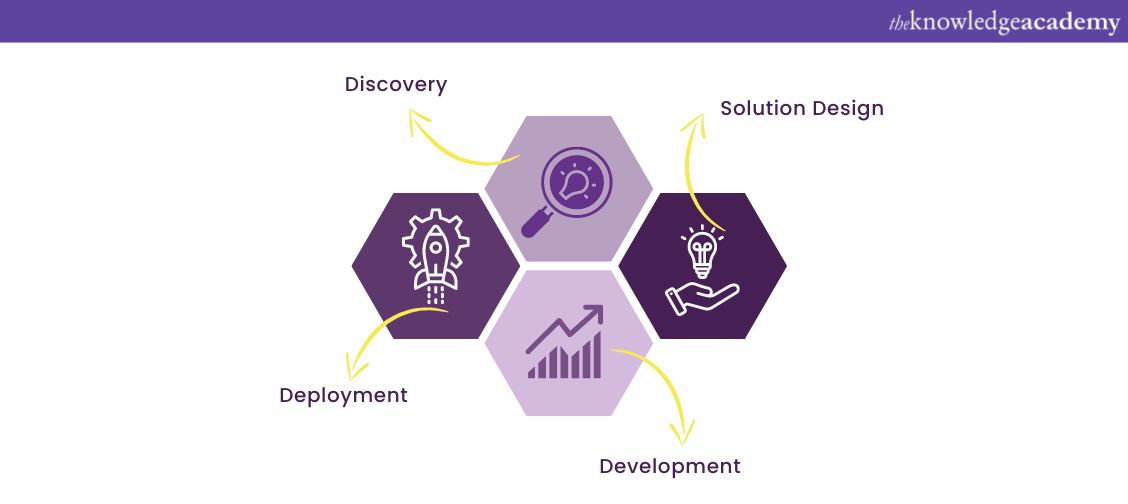We may not have the course you’re looking for. If you enquire or give us a call on +353 12338944 and speak to our training experts, we may still be able to help with your training requirements.
Training Outcomes Within Your Budget!
We ensure quality, budget-alignment, and timely delivery by our expert instructors.

Robotic Process Automation bots are developed to take the load off a worker’s hands by automating business operations. They are programmed to operate within a sequence of stages that direct and ensure their quality of delivery. Such a sequence of stages is referred to as the RPA Life Cycle.
According to a survey by Statista, 24% of large-scale companies have adopted and invested in RPA. This illustrates that including the RPA Life cycle in the workforce scales the business further. Another Statista survey predicts that the worldwide RPA market will scale beyond 10 million GBP by 2030. We shall now discuss the RPA Life Cycle & its management process, explaining every stage of the RPA life cycle in detail. Read on!
Table of Contents
1) Understanding the RPA Life Cycle
2) Different stages of the RPA Life Cycle
a) Discovery
b) Solution Design
c) Development
d) Deployment
3) Benefits of the RPA Life Cycle
4) Conclusion
Understanding the RPA Life Cycle
The RPA Life Cycle’s stages take the bot’s development from its point of discovery to the point of execution. From the first analysis of the client’s requirements by project experts to the execution of deployed RPA bots in the production environment, continuous assessments and iterations form the pivot of all the stages.
Different stages of the RPA Life Cycle

The RPA Life Cycle's stages include practices influencing the bot's development from design to deployment. Let's take you through these stages in detail to understand how it impacts the quality of business delivery:
Discovery Stage
In the first phase, a Process Architect enters the scene to analyse the client’s requirements and decide whether the process will be automated. Suppose the process gets the green signal for automation. In that case, its complexity will then be analysed, followed by the process’s identification by the RPA stakeholders. The next step is designing the Process Definition Document (PDD) in the Solution Stage.
Solution Design Stage
At this point, the steps for task automation are designed. This is where the Technical Architect makes their entry as a systems logistics specialist to collaborate with the Process Architect on a PDD document which details every step of the automation in-depth. The Development Stage of the RPA bots then follows this.
Development Stage
As the Life cycle advances, the Automation Developer contributes by generating Automation scripts in a selected RPA tool. Further, the automation scripts are generated using the initially created PDD document. Whether any programming is necessary depends on the task to be automated. Usually, there are countless situations where programming is not necessary.
Deployment Stage
Once the development and testing of the bot are complete, it is deployed in the production environment. This environment is where users can start utilising it. If there are any concerns with the bot, it is sent back to the Development and Testing teams to resolve the problem. Maintenance and update processes are repeated each time the bot is deployed.
Eager to learn more about Robotic Process Automation, refer to our blog on "RPA testing"
Benefits of the RPA Life Cycle
After introducing the RPA Life Cycle stages this far, let us brief you on its importance for your organisation:
1) Business owners tend to reap the benefits of the RPA Life Cycle over time, considering that RPA software is designed to operate on existing software.
2) The RPA bot’s tailor-made functionality, thanks to RPA Life Cycle Management, makes it very capable of interacting with different business systems simultaneously.
3) The presence of a trustworthy RPA service provider can help eliminate the drawbacks of below-average practices during the integration of RPA bots into business processes.
4) Smart RPA Life Cycle practices translate to quality bot development and its contribution to optimal business delivery value.
Conclusion
Until now, it would have been clear why an RPA Life Cycle is important to quality RPA bot deliveries. Moreover, the RPA Life Cycle emphasises any process's maintenance and troubleshooting aspect because a ‘set it and forget it’ approach will usually do more harm than good. Therefore, to maximise the persistence of their virtual workforce, organisations display interest in adopting RPA approaches.
Gain experience in using Robotic Process Automation and Ui programming techniques. Sign up for the Robotic Process Automation using UiPath course now!
Frequently Asked Questions
Upcoming Business Analysis Resources Batches & Dates
Date
 Robotic Process Automation using UiPath
Robotic Process Automation using UiPath
Thu 12th Dec 2024
Thu 13th Feb 2025
Thu 10th Apr 2025
Thu 12th Jun 2025
Thu 14th Aug 2025
Thu 9th Oct 2025
Thu 11th Dec 2025







 Top Rated Course
Top Rated Course



 If you wish to make any changes to your course, please
If you wish to make any changes to your course, please


